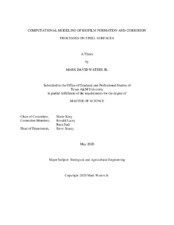| dc.contributor.advisor | King, Maria D | |
| dc.creator | Waters Jr, Mark David | |
| dc.date.accessioned | 2021-01-08T19:50:33Z | |
| dc.date.available | 2022-05-01T07:13:04Z | |
| dc.date.created | 2020-05 | |
| dc.date.issued | 2020-04-08 | |
| dc.date.submitted | May 2020 | |
| dc.identifier.uri | https://hdl.handle.net/1969.1/191914 | |
| dc.description.abstract | The oil and gas industry is in constant search of ways to decrease the losses due to corrosion issues. Although the process of corrosion has been studied extensively, there is very little information available regarding the factors that affect microbially influenced corrosion. For that reason, this research project is aiming at filling in this gap of knowledge. The purpose of this study is to determine the microbially influenced corrosion on metallic surfaces in hydraulic oil fracturing and create computational models for the formation of biofilms.
To conduct this experiment, stainless steel type 304 coupons were used. The coupons were placed in different environments within the flow system: some coupons were left untreated (not exposed to fracturing water), some placed in the fresh fracturing water in a stationary state, and the rest of the coupons were placed in a dynamic flow with the fracturing water. All of the coupons were exposed in an incubator to a constant temperature of 70 Celsius for more accurate results when comparing them to real-world situations. Each week coupons were taken out of the chamber so the surfaces could be imaged and analyzed using Atomic Force Microscopy in conjunction with Analysis System Workbench software.
The results showed that coupons in a stationary state will corrode at a faster rate than coupons in a dynamic flow. Untreated coupons will only exhibit minor changes over time. The faster rate could have been due to more salts incorporating into the biofilm on the surface of the stationary coupons leading to an increase in weight. This was expected because weight was an independent variable that determined the outcome for the rate of corrosion. The overall trend for biofilm formation on stainless steel was visualized by atomic force microscopy and the image analysis allowed for the creation of a predictive computational model to show how corrosion will form on the surface of metals. | en |
| dc.format.mimetype | application/pdf | |
| dc.language.iso | en | |
| dc.subject | atomic force microscopy | en |
| dc.subject | biofilm | en |
| dc.subject | computational modeling | en |
| dc.subject | microbially influenced corrosion | en |
| dc.subject | multimodal analysis | en |
| dc.title | Computational Modeling of Biofilm Formation and Corrosion Processes on Steel Surfaces | en |
| dc.type | Thesis | en |
| thesis.degree.department | Biological and Agricultural Engineering | en |
| thesis.degree.discipline | Biological and Agricultural Engineering | en |
| thesis.degree.grantor | Texas A&M University | en |
| thesis.degree.name | Master of Science | en |
| thesis.degree.level | Masters | en |
| dc.contributor.committeeMember | Lacey, Ronald E | |
| dc.contributor.committeeMember | Sadr, Reza | |
| dc.type.material | text | en |
| dc.date.updated | 2021-01-08T19:50:34Z | |
| local.embargo.terms | 2022-05-01 | |
| local.etdauthor.orcid | 0000-0001-7895-0071 | |


